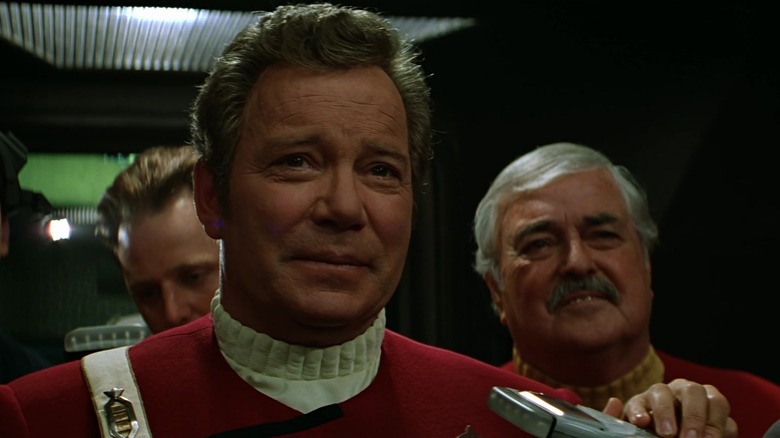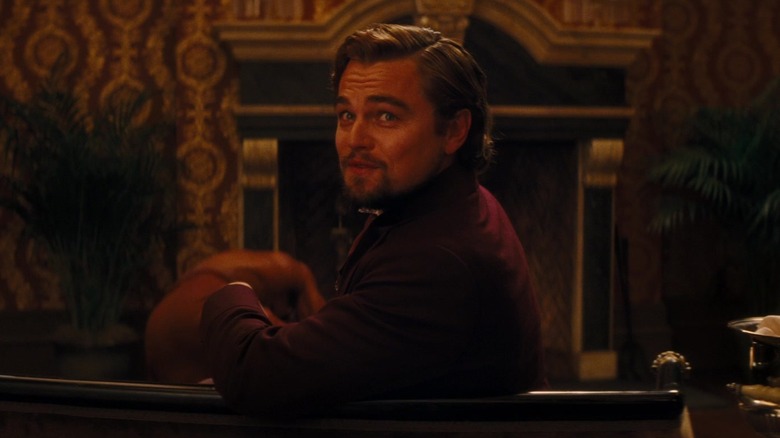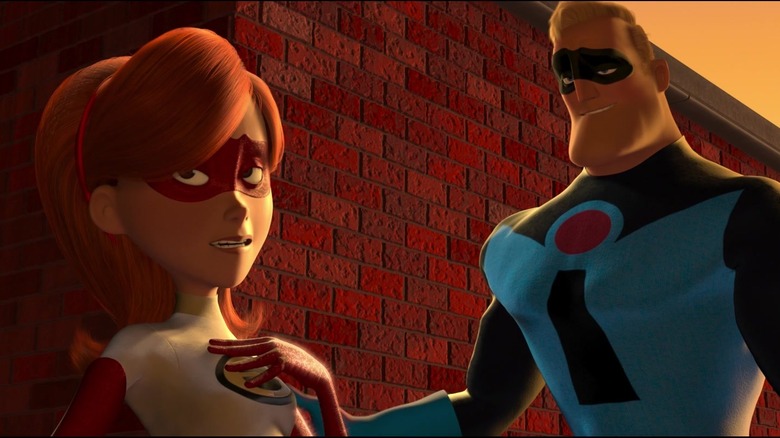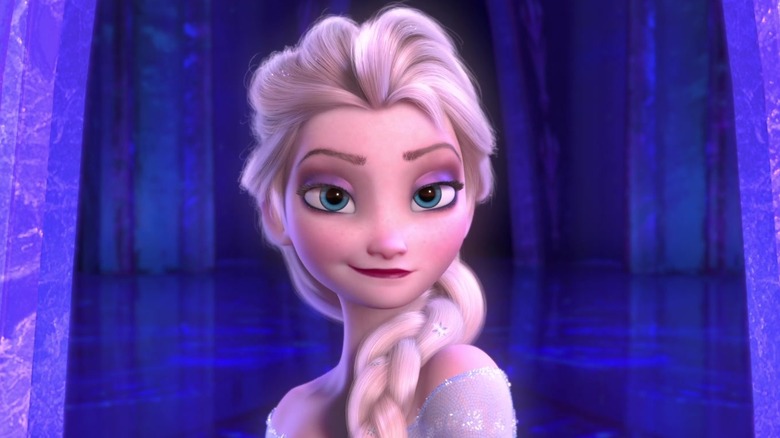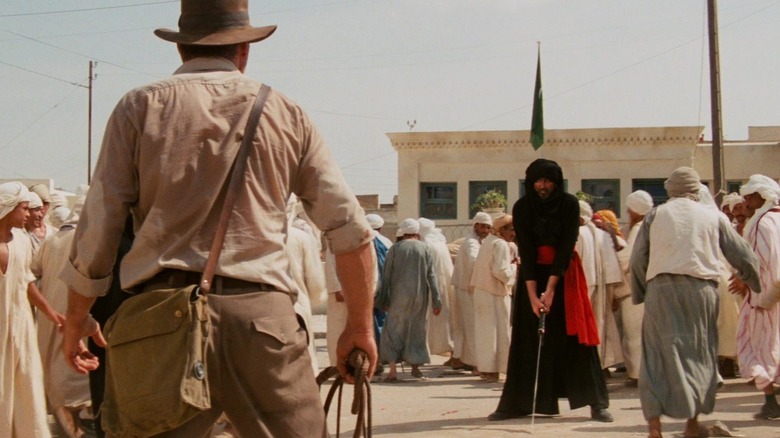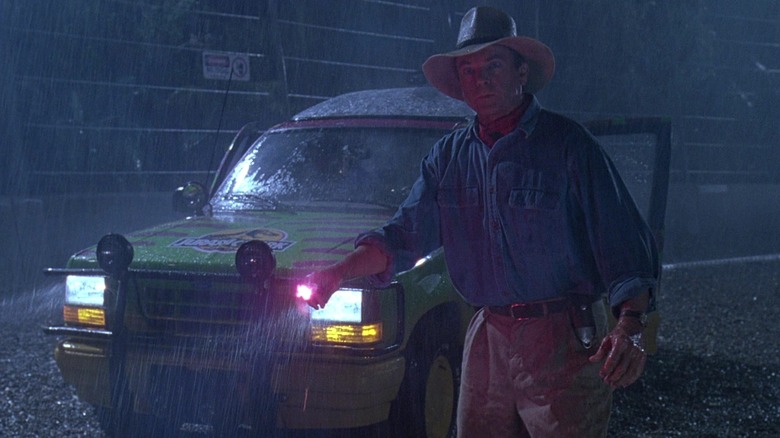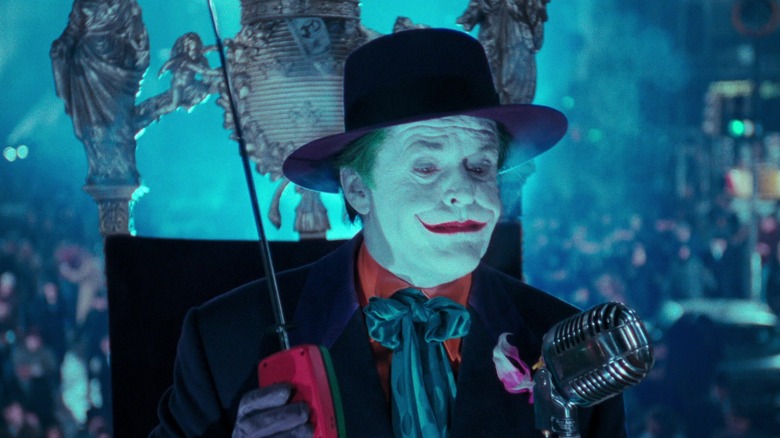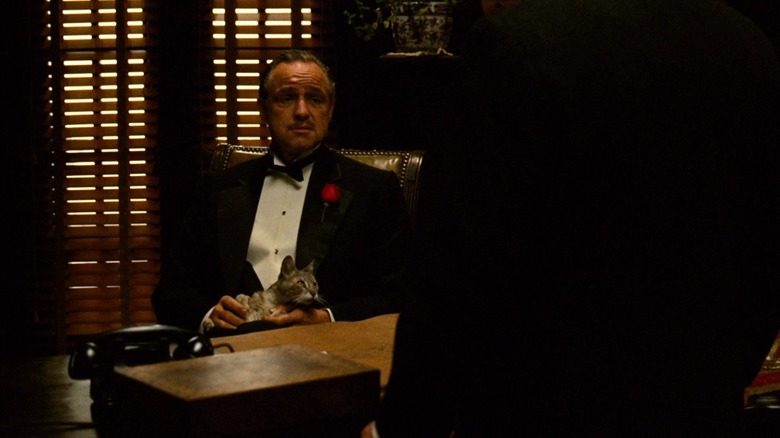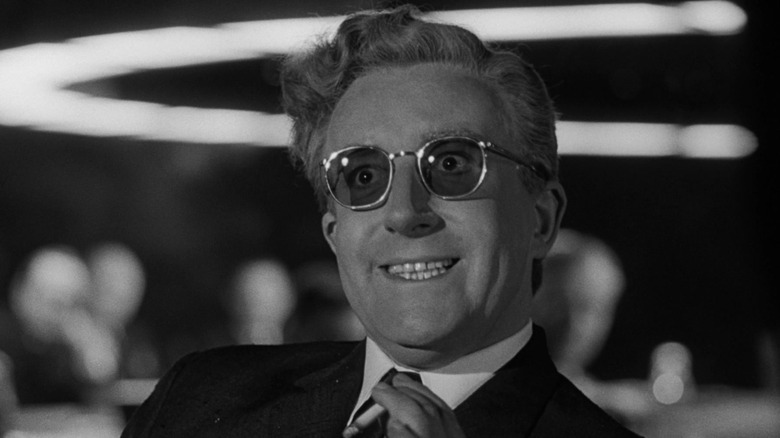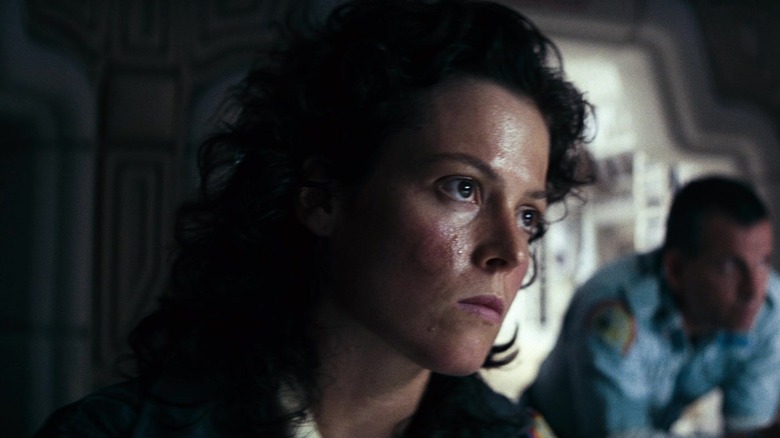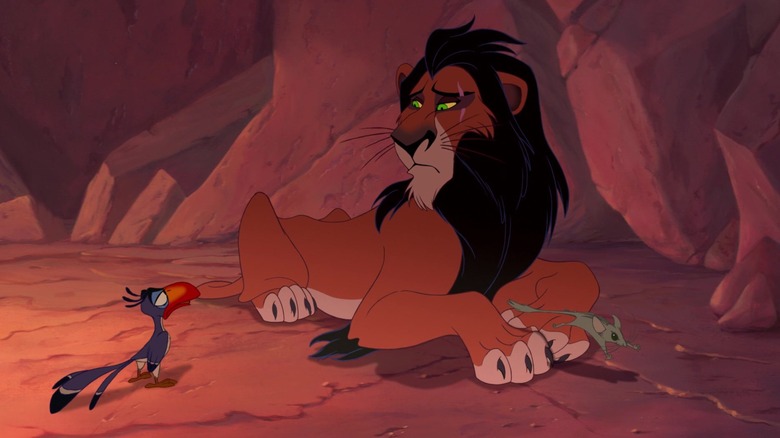Unfilmed Scenes That Completely Change Movies
In most cases, there's usually a good reason why deleted scenes are left on the cutting room floor. Certain moments just don't fit neatly into a film's narrative or present any ideas that impact the experience in a meaningful way. Yet viewers still love to discover hidden parts of their favorite films. Given that unused clips often feature potential story directions and unseen interactions between characters, there's a lot of concealed lore for fans to chew on. It's basically like altered history for movies and it's what makes people obsess over every unutilized segment they can find. But, what about scenes or concepts that never even made it in front of the camera?
Some film ideas don't even live past initial screenplay drafts and storyboarding. Maybe it's a different opening that was ultimately trashed or an early direction for the story that eventually got scrapped. Some of the most highly acclaimed films have unfilmed sequences that could've potentially changed their legacies forever. So, let's take a look at some of the most intriguing and mind-blowing scenes that never made it off the page.
Shatner's cut cameo in Star Trek (2009)
One of the most memorable moments of J.J. Abrams' 2009 reboot of "Star Trek" is Chris Pine's Kirk meeting Leonard Nimoy's Spock on Delta Vega. However, Nimoy wasn't supposed to be the only original cast member to appear, as William Shatner was also meant to reprise his role as Kirk. As described by the film's co-writer Roberto Orci during a writer's roundtable discussion for The Hollywood Reporter, they began the production process intending to feature Shatner.
"We wrote a scene for William Shatner at the end of the movie where Spock, played by Leonard, gives his young self, played by Zach Quinto, something he'd kept with him," said Orci. "It was basically a recording of Kirk singing "Happy Birthday" to him for the last time before he went off to die in 'Star Trek VI.'" While it might seem like a standard cameo on paper, it could've had a huge emotional impact on fans. Not only would this cameo further acknowledge the timeline of Nimoy's Spock, but it would've also highlighted Kirk and Spock's powerful friendship.
Sadly — according to Orci — Abrams scrapped the interaction before they started shooting since he believed it leaned too much into fan pandering. Still, fans likely would've gone nuts for it and many Trekkies will now be left wondering what could've been.
The missing backstory of Django Unchained
While Quentin Tarantino's 2012 film "Django Unchained” contains many captivating characters, there is one whose intriguing backstory was discarded before the cameras even started rolling. Despite Django's wife, Broomhilda "Hildi" von Shaft (Kerry Washington), acting primarily as a personal motivation for the slave turned bounty hunter, she initially had a much larger story.
In the early drafts of the script, Tarantino crafted a wider narrative for Hildi that would depict her experience as a slave. There were planned sequences involving her being sold to a cut character named Scotty Harmony — who was believed to be played by Jonah Hill — and developing a sense of power in their relationship. It all would've led to a fateful poker game between Scotty and Calvin Candie (Leonardo DiCaprio) where Scotty is killed and Calvin takes Hildi as his prize. Not only would these scenes have fleshed out some missing elements in Hildi's story, but they also would've given her a more compelling arc and a distinctive voice. Instead, she's basically a damsel in distress, and it's a shame that her potential was wiped away before anyone could see it.
The Incredibles almost had a different opening
The early moments of "The Incredibles" display some nostalgic heroism and set the stage for a villainous reveal. Yet this approach wasn't always a part of the plan. In a behind-the-scenes interview with director Brad Bird, he describes an alternate opening that introduces Bob (Craig T. Nelson) and Helen Parr (Holly Hunter) at a neighborhood barbeque.
There, they try to blend in as normal people but are put in a predicament when Bob is forced to fake an injury after accidentally slamming a butcher's knife on his fingers. Even wilder is that Syndrome (Jason Lee) appears in this version to fight Bob and Helen at their home. The supervillain catches the duo off guard and even defeats them before a baby incarnation of Violet thwarts his plans.
This vastly different inception of Bob, Helen, and especially Syndrome would have reshaped the entire film. Syndrome's backstory of being rejected by Mr. Incredible would likely be erased. There would be no context for the glory days of heroes and why they're no longer around. Plus, Bob's motivation to be a hero again wouldn't exist. Overall, Bird made the right choice to abandon this potential sequence as the film's definitive opening establishes a much cleaner narrative.
Frozen nearly had an epic finale fight
When thinking about Disney's impressive roster of villains, it's weird to think that Elsa from "Frozen" nearly joined them. But it almost happened, and there were planned scenes that focused on showing Elsa's evil powers and motivations.
In an interview with Entertainment Weekly, producer Peter Del Vecho delved into Elsa's personal story as an evil ice queen and the epic final battle that would've ensued. Instead of being an outcast, Elsa was originally depicted as a scorned lover who was left at the altar. She then turned her heart to ice so that she would never love again and became determined to destroy Arendelle.
This all led to a far more action-oriented battle scene where Elsa would conjure minions of her own –- at least according to Del Vecho. "The ending involved a big epic battle with snow monsters that Elsa had created as her army," he explained.
Where the ending of "Frozen" is more emotional, this modified version is much more chaotic and combative. It would have left a different impression on viewers and possibly could've established itself as one of the darker princess movies in Disney's history. We'll never know what this movie fully could have been, since Elsa's evil arc was nixed early on in the proceedings. But maybe one of the upcoming "Frozen" sequels can make this massive fight concept a reality.
Indiana Jones almost found himself in a whip vs. sword fight
One of the more iconic moments of "Raiders of the Lost Ark" is undoubtedly when Indiana Jones proves that a gun can outduel a sword any day. However, Indy was originally supposed to use another one of his trademark weapons in this bout. During an AMA session on Reddit, Harrison Ford talked about how this scene changed due to him being sick on the day of the filming. "It was meant to be the ultimate duel between sword and whip," said Ford, "I was suffering from dysentery [and], really, found it inconvenient to be out of my trailer for more than 10 minutes at a time."
With the proposed fight likely taking multiple days to shoot, Ford suggested to director Steven Spielberg that he just shoot the swordsman, and the rest is history. "He flourished his sword, I pulled out my gun and shot him, and then we went back to England," said Ford. While the original idea of Indy using his whip to take out not just one, but a bunch of blade-wielding baddies sounds awesome, what we got is much more fitting to Indy's style. More importantly, the slick gunshot from Indy grew to become an iconic piece of his legacy and defines why he's such a beloved figure in cinema.
A gripping T-Rex scene that was never filmed for Jurassic Park
The "Jurassic Park" franchise has some of the most thrilling chases in cinematic history -– especially when the T-Rex is involved. Yet there was one suspenseful sequence from the first film that never got used. According to some pre-production storyboards from dinosaur supervisor Phil Tippett, there was a scene where Alan Grant (Sam Neill), Tim (Joseph Mazzello), and Lex (Ariana Richards) attempt to sidestep a T-Rex at a nearby jungle lagoon.
Tippet's illustrations see the trio arrive at a serene lagoon to find a path toward safety. Unfortunately, the only things they discover are a deflated raft, an aging dock, and a sleeping T-Rex. What follows is a tense sequence of the group quietly trying to avoid waking the beast while inflating the raft. Although they do manage to get the float working, the T-Rex gets up and delivers a big fright before the group sails downriver. Not only would the inclusion of this narrow escape help further define the relationship between Alan and the kids, but it also could've delivered a tense homage to a similar moment from Michael Crichton's novel.
Although Steven Spielberg desperately wanted to include the lagoon concept, he was unfortunately stopped short of doing so due to concerns about stretching the budget and the effects team too thin.
Robin's origins were originally in Tim Burton's first Batman movie
It's no secret that there were multiple attempts to include an incarnation of Robin in Tim Burton's "Batman" films, and there was even a scene planned for Robin's story to unfold in the first film. In an interview with 13 Dimension, "Batman" co-writer Sam Hamm revealed that they had put together a sequence for the film involving Joker (Jack Nicholson) slaying Robins parents, the Flying Graysons. Hamm described the scene as a wild chase where Batman (Michael Keaton) tails Joker, where "the Joker looks in his rearview mirror and sees, of all things, Batman charging toward him on horseback. So he panics. He swerves into Gotham Park and, in the course of making his escape, accidentally kills the Flying Graysons, a husband-and-wife high-wire act performing as part of the Gotham Bicentennial. But ... their kid survives. And he's mad. You can fill in the rest."
Sadly though, despite this entire concept being completely storyboarded and written, it ultimately didn't get past initial cuts. According to Hamm, the film was already going over budget and the studio decided to ax Robin's presence from the film. If this storyline made it in front of the camera, it would've changed everything we know about Keaton's time as the Caped Crusader. Fans could've seen him as more of a mentor than a solo act and it possibly would have reconstructed the story of "Batman Returns."
The return of The Don is cut short
While fans of "The Godfather" were likely thrilled to see James Caan reprise his role as Sonny Corleone at the end of "The Godfather: Part II," they were also probably frustrated that Marlon Brando didn't come along with him. Well, it wasn't from lack of trying. Originally, it was written in the sequel's script for Brando to reappear in a flashback as Vito Corleone. However, Brando declined to return — possibly due to continual disputes with the studio. So, this cameo never happened and the final scene of the film feels a tad incomplete without it.
Sure, Francis Ford Coppola was able to write Brando's appearance out of the film without much of an issue. But, the final scene of "The Godfather: Part II" is centered on a surprise birthday for Vito without the central figure ever showing. It's a moment that symbolizes the family coming together again and with no appearance from Vito — the literal head of the family — there's something noticeably missing. Plus, the audio of everyone saying surprise to Vito is awkward and needs a reemergence of Brando to make it fully satisfying. If the idea of Brando returning as Vito would've stayed intact, we'd be talking about the ending of the sequel even more highly than we already do.
Dr. Strangelove initially had a strange story framing
"Dr. Strangelove: Or How I Learned to Stop Worrying and Love the Bomb" is an absolute classic in Stanley Kubrick's filmography, featuring a lot of wildly unforgettable moments. However, Kubrick nearly utilized an intriguing framing device for the story that would've further added to the bizarre nature of the film. One of the early drafts of the script featured a wraparound narrative involving aliens coming to Earth. In this idea, the aliens stumble on the destruction of Earth after the film's finale and what happened is then explained in the events that follow.
Even with so many mind-blowing talking points in "Dr. Strangelove," this potential alien arc could've added another level of strangeness that fans probably would've loved. Just imagine getting a glimpse into the destruction of humanity before witnessing everything that led to it. It would probably change a lot of people's perspective on the film — but also take away some of the ambiguity Kubrick used to make viewers more immersed in the experience. Kubrick clearly had aliens on the brain when making "Dr. Strangelove," and it extended past the titular character's alien hand syndrome.
Alien nearly had a franchise-altering ending
The ending of Ridley Scott's 1979 sci-fi horror masterpiece "Alien" is an all-time classic. It's immensely riveting from start to finish, even though it's just the tipping point for Ellen Ripley's (Sigourney Weaver) heroic evolution. Surprisingly though, Scott almost cut Ripley's victory short in "Alien" with a pitch he made for an alternate ending to the studio. While talking with Entertainment Weekly, Scott mentioned that he initially wanted Ripley's plan to kill the Xenomorph to fail. In this new ending, Ripley's harpoon shot would do nothing to the Xenomorph — leading it to then lunge toward her and rip her head off. After that, things become incredibly eerie, with a sequence that follows where the Xenomorph mimics Dallas' (Tom Skerritt) voice to perform a sign-off for the Captain's Log.
Given the legacy that Ripley and the "Alien" franchise have left on pop culture, it's hard to imagine what the series would be like with this ending. Despite the good and the bad that the "Alien" movies have presented over the years, Ripley dying in this ending would be tough for any fan to stomach. Thankfully, the studio shot this idea down and one of the most recognizable sci-fi franchises was able to live on.
A Scar scene was too disturbing and inappropriate for The Lion King
"The Lion King" features one of the most cherished and devious Disney villains of all time: Scar (Jeremy Irons). But believe it or not, Scar was almost shown to be more vile and devious in an unfilmed scene. Through storyboards, fans can see a sequence where Scar talks with Zazu (Rowan Atkinson) about wanting a queen of his own. Then, as Nala (Moira Kelly) walks into Scar's cave, he tries to court Nala, hoping that she'll become more affectionate towards him. It doesn't work and ultimately leads to the original version of "Be Prepared."
Overall, the situation has an unsettling vibe to it and while it could've made Scar a more frightening villain, the scene was best left carved off. It's a little too disturbing for younger audiences to see and adds a tinge of darkness that surely would've spurred controversy at the time. Even now, fans are mixed about the interaction – with some saying they love the original style of "Be Prepared" but acknowledging that the subject matter might be a little much. Classic Disney villains always have delightful touches of evil to them, but this unused moment with Scar might've propelled the film into bleaker territory some would rather not see.

